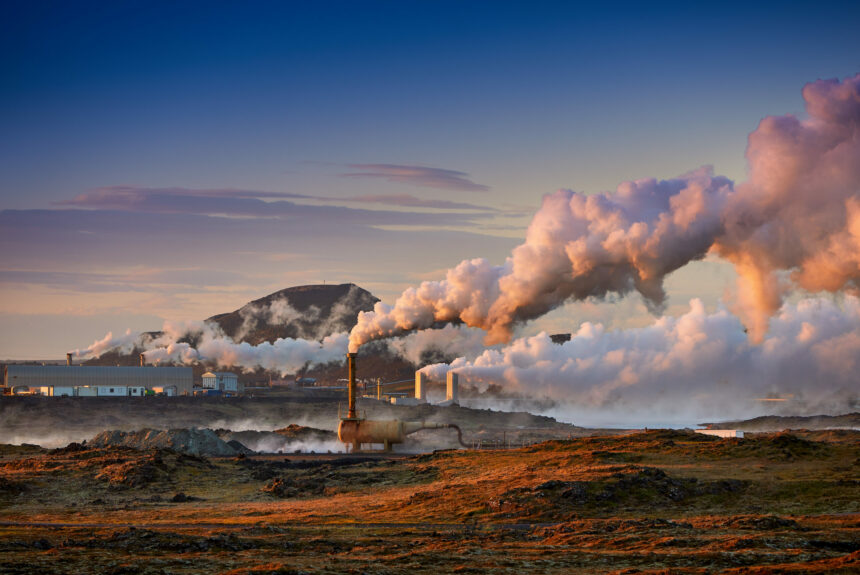Heading into the summer months, Americans across the country place a high priority on affordable, reliable air conditioning. This is particularly true in Texas right now as residents in the Lone Star State are trying to keep cool amidst a record-breaking heat wave. As policymakers explore ways to expand energy supplies and meet environmental objectives, they should turn to geothermal energy production—an abundant power source with literally untapped, enormous potential.
>>>READ: Geothermal Energy Report Predicts Future Drilling Boom in Texas
Geothermal energy production uses the earth’s heat to power homes and heat buildings. Geothermal taps into steam and hot water reservoirs below the earth for direct heat and to power generators. The commercial use of geothermal power has been around for more than six decades, and geothermal heat pumps in homes and buildings date back to the late 1940s.
Traditional geothermal systems used heat and water close to the surface, like hot springs, along with natural fractures in the earth. Advancements in smart extraction technologies, like those used in the oil and gas industry, have increased the potential for geothermal as a firm, clean energy source. Innovation is taking geothermal from a geographically constrained clean power source to one that can be accessible across the globe.
For instance, companies like Fervo have enhanced geothermal systems, which “applies proven technologies– such as horizontal drilling and distributed fiber optic sensing – to geothermal reservoir development, unlocking geothermal power in previously uneconomic locations and dramatically increasing the resource potential for geothermal globally.” Other technologies use a closed-loop system, which pumps fluids like antifreeze through a closed loop of underground piping that can either connect to a home heat pump or power a turbine for power generation. For instance, GreenFire Energy is using its technology to turn non-producing oil and gas wells into productive, clean geothermal sources of power.
Superhot rock geothermal is another form of enhanced or engineered geothermal system that offers the potential for “always-on” clean power that could be readily available worldwide. The process consists of drilling into the earth’s core, an estimated two to twelve miles, to reach rocks that are 400 degrees Celsius (752 degrees Fahrenheit). Companies would inject water down and it would become supercritical, where there is no distinction between a liquid or a gas state and it can move more easily through the fractures in the earth. The absorbed heat can then be transported up the well and provide steam-driven electricity. While drilling to such depths is technologically and economically challenging, innovative companies are finding ways to improve the process.
One company is Quaise Energy, which doesn’t actually drill the rock but vaporizes it. As described in Popular Mechanics, “By replacing conventional drill bits with millimeter wave energy, powered by a gyrotron machine, it’s possible to melt and then vaporize the rock to create many of these deep holes. It took MIT over 15 years to develop the general technique in a lab, eventually demonstrating that millimeter waves could drill holes in basalt. Quaise says its technology will allow it to reach 20 kilometers (12.4 miles) into the ground, where temperatures reach over 900 degrees Fahrenheit.” By implementing a hybrid technique of conventional drilling and vaporizing rock, Quaise could help overcome some of the geologic challenges with deep geothermal. Quaise has raised venture capital funding and is partnering with the Department of Energy’s Oak Ridge National Laboratory to improve its capabilities.
Like the fracking boom that unlocked affordable oil and natural gas in the United States, enhanced geothermal energy production systems could unleash vast quantities of cost-competitive energy with minimal risk to drinking water or the environment. One way to improve the economic outlook for geothermal is to address the policy barriers that stifle its development. A 2019 DOE study concludes that putting geothermal permitting on equal footing with small oil and gas well exploration on federal lands would more than double geothermal electricity generation capacity (from six gigawatts in the business-as-usual case to seven gigawatts).
>>>READ: AltaRock Energy Wants to Power the World Through Geothermal Energy
Several policy reforms could improve the economic outlook for geothermal energy. For instance, the Enhancing Geothermal Production on Federal Lands Act would expedite the process by creating categorical exclusions for National Environmental Policy Act reviews for geothermal exploration activities (similar to oil and gas exploration wells). The bill would also require the Secretary of Interior to identify priority areas for geothermal development on federal lands. Furthermore, a recent report by the Clean Air Task Force identified ways to better coordinate research and development across the federal government, and identified ways in which the private sector could work more productively with research institutions and across the industry.
Congress should also explore how subsidies for mature technologies adversely impact innovative, emerging technologies. In a recent interview with S&P Global Insights, Fervo Energy CEO Tim Latimer commented on how policies like investment tax credits can hamstring new technologies “because the big financiers of tax equity have a rinse and repeat model and they like to go with big companies, big transactions and proven technologies.” It’s difficult enough for new energy technologies to reach the market. Government policies that create higher barriers to entry, lengthen timelines, raise costs, and distort financing unnecessarily make it more difficult.
Geothermal energy production is the promise of an abundant, clean, and dependable power source. As the world looks to expand and diversify its energy needs while meeting its environmental ambitions, geothermal could play a very significant role.
The views and opinions expressed are those of the author’s and do not necessarily reflect the official policy or position of C3.
